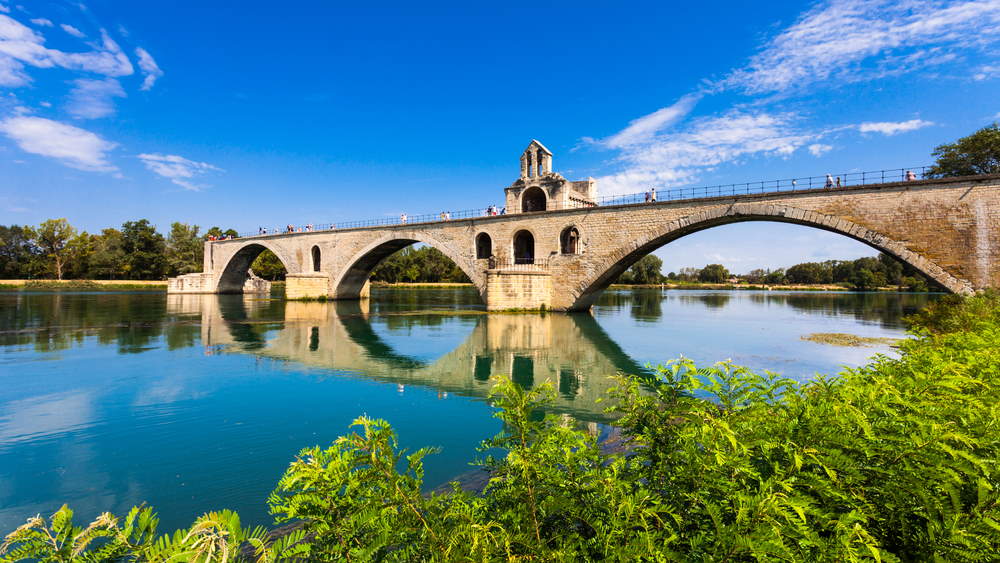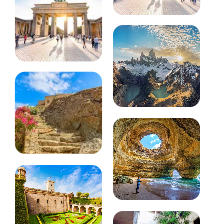Visit the Pont d’Avignon

This bridge, which has made all the children of France and Navarre sing with its famous nursery rhyme, has a very special history. Victim of the whims of the Rhône and of men who never stopped fighting each other, the Pont d’Avignon is rich in history, anecdotes and legends that you can discover during your stay in Avignon. Because, yes, in the south, we don’t say “in Avignon” (it’s not nice), but “in Avignon”. So much for the first anecdote. If you’d like to discover lots more, don’t hesitate to take one of our specially designed tours, so you don’t miss out on anything of the beautiful city of Avignon and its famous bridge.
How do I visit the Pont d’Avignon or Pont Saint-Bénezet?
You can admire the Pont d’Avignon by day or night, as it can be seen from afar. Magnificent photos can be taken from Avignon Intra-muros, or the Ile de la Barthelasse. The Pont d’Avignon has nothing but good profiles! In the evening, the bridge lights up, and the advantage, if you’re a keen photographer, is that there won’t be anyone else on it.
You can, of course, walk on the cobbled floor of the Pont d’Avignon for the price of a ticket, and the history of the bridge will be told to you through the audio guides, the exhibition, the films… You’ll also enjoy a breathtaking view of the Rhône and the city walls.
Discover the Pont d’Avignon in its original state
During your visit, films, an exhibition and touch-screen tablets will enable you to discover the Pont d’Avignon as it was when it was built. A real technical feat, it represented a never-ending construction site for the workers of the time, in order to keep the 2 banks of the Rhône connected. Teams of researchers working under the aegis of Greater Avignon and the CNRS (French National Centre for Scientific Research) have developed museographic devices that enable the bridge to be reconstructed in 3D, respecting the landscapes of the different periods. It’s a long-term project that’s well worth seeing! This unique experience takes place in 3 different ways:
- The “Pont retrouvé” museum area, with films and an exhibition presenting the mysteries of the Pont d’Avignon Saint Bénezet.
- Visitors can use touch-screen tablets to discover the tumultuous history of this legendary bridge through films, images and fun quizzes!
- Discover the legends of the Pont d’Avignon through an audio guide exhibition.
Practical info: opening times, access, payment methods and prices for the Pont d’Avignon
Pont d’Avignon is open all year round, 7 days a week.
1 – Visiting times :
- From 1 January to 8 April: 10.00 am to 5.00 pm
- From 9 April to 6 November: 10 am to 6 pm
- From 7 November to 31 December: 10am to 5pm.
2 – Prices
- Full price: €5
- Reduced rate : 4 €.
- Free for children under 8.
- Children aged 8 to 17 + students: €4
3 – Payment methods
- Holiday vouchers,
- Species,
- Cheque,
- American Express,
- Credit card
4 – Equipment
Lift, Toilets, Car park and Car park nearby.
The bridge site is accessible to people with reduced mobility.
A special audio commentary is available for the visually impaired.
Where can I park to visit the Pont d’Avignon?
1 – Free parking
You won’t find any in the city centre, or only very rarely, as the locals are very familiar with them and prefer this type of parking.
Park-and-ride facilities
There are 2,500 free parking spaces at Piot and Les Italiens. A free shuttle bus takes you to the city centre every 5 to 10 minutes from 7am to midnight from Les Italiens, and from 7am to 8.30pm from Les Piot.
If you prefer to walk, it will take you 5 minutes from Les Piot and 15 minutes from Les Italiens to reach the city centre.
Other free parking
The L’épi car park is a 10-minute walk from the city centre, and there is no shuttle bus service to this car park.
2 – Pay car park
Palais des papes car park
A secure underground car park open all year round. This is the nearest car park to the Pont d’Avignon.
Rate: €0.20 to €0.50/15min from 8am to 8pm outside July and €0.10 to €0.60/15min in July.
How did the Pont d’Avignon break?
Heavy flooding of the Rhône in 1603 destroyed the first arch, and 3 others collapsed 2 years later for the same reason. Repairs began in 1628, but the plague epidemic then raging in the country meant that the bridge was not viable again until 1633. It took only 2 months for the Rhône to destroy 2 arches again, but the city could no longer afford the many repairs and maintenance work required on the Avignon bridge. So it has remained as you see it today.
The history of the Pont d’Avignon
According to legend, it was a young shepherd from the Vivarais region named Bénezet who received the heavenly order to build a bridge in Avignon.
In fact, although the real name of the Pont d’Avignon is the Pont Bénezet le jeune berger, its construction, which took several centuries to complete, began in 1177. It was a complicated construction project, built on a bed of pebbles, which turned into a permanent building site. At the time, it was 900 metres long, 4 metres wide and had 22 arches. It played a vital role in controlling river traffic and linking Villeneuve to the city of Avignon (boat crossings were often dangerous), and it became essential to the papal court when it moved into the Popes’ Palace. But climatic changes in the 15th century and afterwards altered the hydrology of the Rhône, making it more powerful and more devastating, with heavy floods accumulating over the centuries. Despite the will and courage of the people of Avignon, the project had to be abandoned for lack of funds in the 17th century. Louis XIV was one of the last people to cross the Pont d’Avignon, and despite his attachment to the building, which he wanted to own, he refused to pay for its reconstruction, as did those who followed in his footsteps.
200 audioguided tours for cities all around the world
Download
